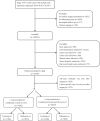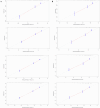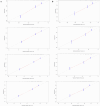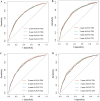Conditional survival analysis and real-time prognosis prediction in stage III T3-T4 colon cancer patients after surgical resection: a SEER database analysis
- PMID: 38639915
- PMCID: PMC11031473
- DOI: 10.1007/s00384-024-04614-x
Conditional survival analysis and real-time prognosis prediction in stage III T3-T4 colon cancer patients after surgical resection: a SEER database analysis
Abstract
Background: Conditional survival (CS) takes into consideration the duration of survival post-surgery and can provide valuable additional insights. The aim of this study was to investigate the risk factors associated with reduced one-year postoperative conditional survival in patients diagnosed with stage III T3-T4 colon cancer and real-time prognosis prediction. Furthermore, we aim to develop pertinent nomograms and predictive models.
Methods: Clinical data and survival outcomes of patients diagnosed with stage III T3-T4 colon cancer were obtained from the Surveillance, Epidemiology, and End Results (SEER) database, covering the period from 2010 to 2019. Patients were divided into training and validation cohorts at a ratio of 7:3. The training set consisted of a total of 11,386 patients for conditional overall survival (cOS) and 11,800 patients for conditional cancer-specific survival (cCSS), while the validation set comprised 4876 patients for cOS and 5055 patients for cCSS. Univariate and multivariate Cox regression analyses were employed to identify independent risk factors influencing one-year postoperative cOS and cCSS. Subsequently, predictive nomograms for cOS and cCSS at 2-year, 3-year, 4-year, and 5-year intervals were constructed based on the identified prognostic factors. The performance of these nomograms was rigorously assessed through metrics including the concordance index (C-index), calibration curves, and the area under curve (AUC) derived from the receiver operating characteristic (ROC) analysis. Clinical utility was further evaluated using decision curve analysis (DCA).
Results: A total of 18,190 patients diagnosed with stage III T3-T4 colon cancer were included in this study. Independent risk factors for one-year postoperative cOS and cCSS included age, pT stage, pN stage, pretreatment carcinoembryonic antigen (CEA) levels, receipt of chemotherapy, perineural invasion (PNI), presence of tumor deposits, the number of harvested lymph nodes, and marital status. Sex and tumor site were significantly associated with one-year postoperative cOS, while radiation therapy was notably associated with one-year postoperative cCSS. In the training cohort, the developed nomogram demonstrated a C-index of 0.701 (95% CI, 0.711-0.691) for predicting one-year postoperative cOS and 0.701 (95% CI, 0.713-0.689) for one-year postoperative cCSS. Following validation, the C-index remained robust at 0.707 (95% CI, 0.721-0.693) for one-year postoperative cOS and 0.700 (95% CI, 0.716-0.684) for one-year postoperative cCSS. ROC and calibration curves provided evidence of the model's stability and reliability. Furthermore, DCA underscored the nomogram's superior clinical utility.
Conclusions: Our study developed nomograms and predictive models for postoperative stage III survival in T3-T4 colon cancer with the aim of accurately estimating conditional survival. Survival bias in our analyses may lead to overestimation of survival outcomes, which may limit the applicability of our findings.
Keywords: Conditional cancer-specific survival; Conditional overall survival; Nomogram; Stage III T3–T4 colon cancer; Surveillance, Epidemiology, and End Results.
© 2024. The Author(s).
Conflict of interest statement
The authors declare no competing interests.
Figures







References
-
- Zheng X, Cen W, Zhu J, Ye L (2023) Prognostic value of tumor deposits in stage III colorectal cancer patients with different N stages: a population-based, retrospective, cohort study. Ann Surg Oncol 30(13):8067–8073. 10.1245/s10434-023-14338-x - PubMed
-
- Dekker YW, Peeters KC, Putter H et al (2010) Metastatic lymph node ratio in stage III rectal cancer; prognostic significance in addition to the 7th edition of the TNM classification. Eur J Surg Oncol 36:1180–6 - PubMed
-
- Fokas E, Fietkau R, Hartmann A et al (2018) Neoadjuvant rectal score as individual-level surrogate for disease-free survival in rectal cancer in the Cao/Aro/Aio-04 randomized phase iii trial. Ann Oncol 7:1521e7 - PubMed
MeSH terms
Grants and funding
- 2022LYF17094/Longyan City Joint Funding
- 2022LYF17094/Longyan City Joint Funding
- 2022LYF17094/Longyan City Joint Funding
- 2022LYF17094/Longyan City Joint Funding
- 2022LYF17094/Longyan City Joint Funding
- FLY2018CJC010044/Longyan Basic Research and Young Talents
- FLY2018CJC010044/Longyan Basic Research and Young Talents
- FLY2018CJC010044/Longyan Basic Research and Young Talents
- 2021J01122670/Natural Science Foundation of Fujian Province
- 2021J01122670/Natural Science Foundation of Fujian Province
- 2021J01122670/Natural Science Foundation of Fujian Province
- 2021J01122670/Natural Science Foundation of Fujian Province
LinkOut - more resources
Full Text Sources

